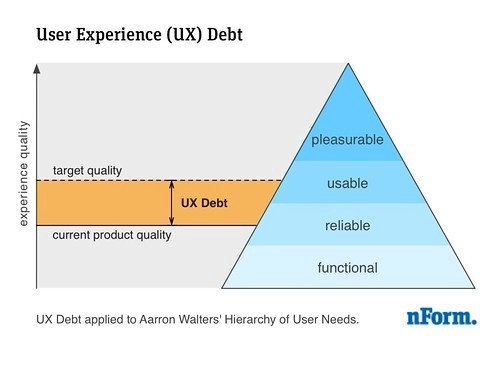
Making good on your UX debt

Have you ever loaned a friend something, with only their word they’d pay you back or return the item? It’s understood that your friend will eventually make good on their debt. But what happens when that debt isn’t repaid? Are you forced into the uncomfortable position of having to ask them to fulfill their obligation? Or do you wait silently, in hopes your friend will come through? And what happens to your friendship in the meantime? If left unchecked, that debt can erode even the strongest of relationships.
This may sound like an episode of Oprah, but these kinds of situations happen every day—even in the digital world, and especially with user experience.
It’s called UX debt, and it’s a relationship with your users you can’t ignore. Today I want to take a look at what debt means when it comes to user experience so you can stay on good terms with your users.
What is UX debt?
The concept of debt is easy enough to understand. Something is exchanged without “payment” but expected to be repaid in the future. In some cases, it’s goods or services that will be paid for at a later date.
UX debt is incurred when users feel their experience could’ve been better. In other words, whenever they expected more from your product or service, or you know you could've delivered a better product.
But all debt isn't created equally. For example, if you loan your 10-year-old cousin $5, you probably won’t be super put out if he never pays you back. On the other hand, if you loan your best friend $100, you’re going to be pretty disappointed in her if you never hear from her again.
The same is true for UX debt. For example, if you’re looking online for the hours for your neighborhood mom-and-pop corner store, you’re probably not going to mind that it’s just a landing page with a few basic bits of information. Was it functional and reliable? Sure. Delightful? Probably not. But does that really change your opinion of the corner store?
Now imagine you’re visiting a streaming video site. You pay them a monthly fee for a service, but there’s just something missing. The site functions and you can navigate easily, but you’re left feeling like they just didn’t try hard enough to make the experience awesome for you. Maybe the copy was a little too corporate, or the visual design was nothing to write home about. That company now has a debt on the books with you.
Aarron Walter’s Hierarchy of User Needs, applied to UX debt by nForm, is a great illustration of this concept:

Types of UX debt
While you may be able to avoid debt in your financial life, it’s nearly impossible to avoid it digitally. Andrew Wright, Senior Customer Experience Content Strategist at ATB Financial, buckets UX debt into two categories: intentional and unintentional. Let’s take a look at what each means.
Intentional UX debt
There will be times when your project just doesn’t have the time, money, or resources to do it right. Something will have to be sacrificed, and there’s a good chance your users will notice. Whenever you willingly cut corners that will impact the user experience, you’re bound to be in the hole with your users.
Unintentional UX debt
But not all debt is intentional. One of the most important rules of good UX is to remember that you’re not your user. But your users aren’t always themselves either. By that, I mean that users will change—constantly. What works for them today may not in a few months or a year. You can also unintentionally get yourself in the red with users if you’re not diligent about understanding them before you build your product. For example, if you throw a wide net and create a general persona, you risk missing out on specific traits your audience possesses. For example, just because a big chunk of the general population seems pretty stoked about the newest Star Wars film, that doesn’t mean your audience is as well. And making that assumption will only make them feel like you don’t really know them at all.
How to manage your UX debt
No matter how hard you try, you’re going to rack up some unintentional UX debt at a minimum because your users will be constantly changing. But that doesn’t mean you can’t stay on top of that debt.
One of the best ways to keep your UX debt in check is continual research and user testing. Regardless of what kind of debt you’ve racked up, keeping your finger on the pulse of your users will assure you understand what they expect from you, and can prioritize improvements accordingly.
Keep your relationship with your users healthy and strong. Stay connected with your users through consistent research and testing, and get those debts off the books as quickly as possible.
Want to learn more?
If you’d like to learn how UserTesting can help you understand your customers through on-demand human insight, contact us here.





